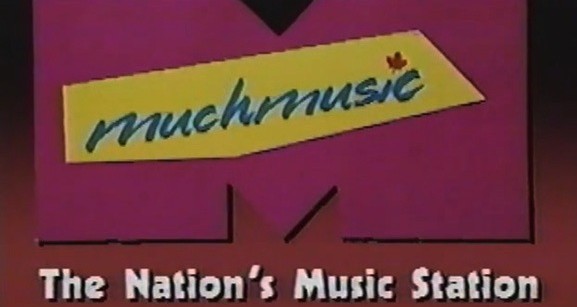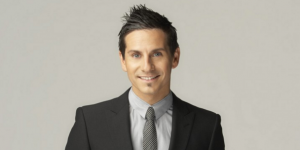 Film + TV
Film + TV
MuchMusic at 30: How 299 Queen Street West celebrated its complex legacy
by Ryan McNutt
September 3, 2014
A key building block in our country's musical culture celebrates three decades with a 30-minute special.
Anyone who happened to flip to Much on their TV this past weekend without context must have been a bit bewildered. “Why is Corey Hart’s ‘Sunglasses at Night’ on? Nirvana’s ‘Smells Like Teen Spirit?’ Maestro Fresh Wes’ ‘Drop the Needle?’ What on earth is happening here?”
Those who were inundated by promos during the MTV VMAs a week ago, or who follow Much on Twitter, would have gotten the hint: the channel was celebrating its 30th anniversary this weekend, marking three decades since J.D. Roberts and Christopher Ward bounded through a green-screen and launched “the nation’s music station.” (Trivia note: the first proper video played was Rush’s “The Enemy Within.”) The network celebrated the occasion by programming nearly all old content during its daily Videoflow timeslots, as well as airing a countdown of its 100 Greatest Videos Ever.
But the main attraction was a prime-time special, surveying 30 years of Much history, which aired Saturday night and repeated several times through the long weekend. The commercial promoting the special, repeated ad nauseam during the VMAs, featured old clips seemingly unseen (or only seen in crappy YouTube form) for ages: interviews with Nirvana, Kanye West, Marky Mark, INXS and many more, paired with fleeting glimpses of various VJs from over the years. In the context of MTV’s hyper-immediate awards show, it was like a sharp blade of the past stabbing itself into the present each and every commercial intermission.
This was odd enough in comparison to the VMAs. But it was also odd because it felt like the first time in years Much has seemingly given a shit about its own history.
* * *
In truth, I was incredibly excited about Saturday’s special — or, at least, I was until I looked at Much’s barren schedule and saw it was a mere 30 minutes long.
Are you shitting me!? 30 minutes!? Taking out commercials that’s a paltry 44 seconds per year that MuchMusic — from this point forward, I’ll be mostly sticking with its original name — has been part of the Canadian culture landscape. I give props to the network for building out an ongoing 30th anniversary website with some classic highlights and insights from individuals who were part of them, as well as its all-old-school video programming through the weekend. But was 30 minutes really all the time available to properly celebrate one of the building blocks of our country’s musical culture? Were viewers so desperate to start watching Police Academy and Police Academy 2 back-to-back immediately afterwards? (That’s not a joke; that’s actually what followed the special’s first airing on Saturday night, though it did fit with the 1984 theme.)
I’ve long been frustrated by modern MuchMusic’s ahistoricism, its unwillingness to acknowledge anything but the most recent past. Clip shows promoting recent MMVAs, for example, would almost never note anything from before the turn of the millennium. While older VJs and personalities remain part of our lives in certain ways — Rick the Temp on ET Canada, George Stroumboulopoulos on his own show (and soon Hockey Night in Canada), Hannah Simone on New Girl, Sook-Yin Lee on Definitely Not the Opera — they go unmentioned or ignored on television. Even when the network created programming ripe for broader context, like the Much Top 10 countdowns, it was rarely willing extend the veil of history back beyond a decade.
The effect of this is that MuchMusic’s cultural impact, while implicitly understood by those of us who grew up with it, is rarely spelled out explicitly. This is a wrong that deserves to be righted, so allow me to do my very small part.
There’s a reason why MuchMusic shows up early in Have Not Been the Same, the definitive take on the rise of Canadian alternative music written by Michael Barclay, Ian A.D. Jack, and Jason Schneider. Alongside CBC radio programs Brave New Waves and Night Lines, and the rise of college radio in general, MuchMusic is credited with being an essential part of transmitting and solidifying underground music in this country, providing an avenue for bands to be discovered without having to conform to the conservative stranglehold of Canada’s commercial radio system.
Despite being a paid cable network for its first five years or so, MuchMusic ended up being the most populist of those outlets, and no wonder: at its peak, music video was a great equalizer. While commercial radio whined about having to meet its CanCon quotas, MuchMusic readily took on videos from Canadian artists to meet its 30 per cent requirement (and, through VideoFACT, funded more than its fair share of them). If you were an emerging Canadian band and could throw a video together, MuchMusic was much more likely to play your music than radio was. The visual component of music video made songs inherently more sticky than radio — your brain had more data to recall — and MuchMusic offered a truly national audience, something rarely available to Canadian artists before to such a degree. The cumulative effect was that while touring Canada remained as much of a geographical challenge as ever, it suddenly was within the realm of reason to find crowds who knew your band’s music, coast-to-coast.
The example of this that Have Not Been the Same’s authors look at in some detail is the Pursuit of Happiness’ “I’m an Adult Now” — a MuchMusic hit even before a cassette or vinyl record had been printed — but you could walk through the past 30 years of Canadian music and pick countless bands who owe a good deal of their national success to MuchMusic: k.d. lang, Blue Rodeo, the Tragically Hip, Rascalz, Our Lady Peace, aw what the hell Marianas Trench, etc., etc. Though not without its limitations, the network was more diverse than its American counterpart, in both musical styles and in race/gender representation. And it was inclusive: the entire format, owing a great deal to its financial constraints, eroded the gap between on-air personalities and the audience. We saw the inner workings of 299 Queen Street West as if we were inside it ourselves — and, sometimes, it truly felt like we were, as we watched our proxies dance on Electric Circus, swoon at an Intimate & Interactive, or camp outside for a glimpse of their pop idols for a Live @ Much.
If the goal (in my view, a noble one) of the CRTC’s Canadian content regulations was to allow us to sustain our own music culture and resist cultural domination from the United States, MuchMusic may be the space in which that goal was most fully realized.
… for a time.
* * *
Last month Bell Media, MuchMusic’s current owners, cut 91 jobs from its in-house production division. The bulk of these were from Much and MTV Canada. Shows like the Damian Abraham-hosted revival of The Wedge — easily the most valiant effort the network has made to recapture some of its old magic — were snuffed out. Unifor, the union representing many of the staff that were fired, commented in a release that with the cuts, MuchMusic had lost, “almost all of their original programming.”
A scan of the network’s current schedule shows the damage: each weekday features Videoflow — no longer with VJ support — through the daytime hours, then a combination of non-music programming, movies, or specials like the VMAs in the evening. There’s not a single element of the ongoing lineup that’s definitively “MuchMusic,” and no people presence’in the slightest. Saturday’s 30th anniversary special might end up being one of the last times we see something distinctly human on Much for a long time.
For years now, Bell has been trying to get the CRTC to reduce its requirement that Much devote 50 per cent of its airtime to music videos, all to no avail. Back in 2010, I criticized the company for this approach — “When challenged by the Internet’s paradigm shift,” I wrote, “MuchMusic didn’t change its argument for why it mattered; it simply stopped arguing” — but, in hindsight, I was probably too harsh. If you read the CRTC’s definition for a music video, it’s quite limiting, and really doesn’t give MuchMusic the ability to shift to other forms of music programming that might be more successful in attracting an audience in the YouTube age.
But that’s not to say that MuchMusic is entirely blameless in its own demise. A comment in one of Crull’s recent interviews is telling: “Kids do not watch music videos on television,” he said. So, if that’s the case… why on earth is MuchMusic trying to reach kids at all?
“Year by year,” write the authors of Have Not Been the Same, “what was eroded at MuchMusic was the sense that rock-‘n’-roll was for grown-ups.” MuchMusic’s ahistorism over the past 10 or 15 years hasn’t been an idle, ill-considered venture. It’s the explicit consequence of deciding that, above all else, MuchMusic was to be a youth network — even as the entire culture around it, enabled by the digital age, was turning its attention to nostalgia, to playing with the artifacts of the past in new and exciting ways.
In a Buzzfeed world, when even kids who grew up in the early 2000s are obsessed with their own histories, why is Much been wasting its time trying to reach “kids” instead of the people who already have an affinity for its product? Imagine a network that regularly played old SnowJobs, Intimate & Interactives, classic episodes of The Wedge and Rap City. What if it interspersed these with retrospectives from some of the old VJs themselves, bringing a curated approach to its offerings? What if it gave national treasure Nardwuar several hours of airtime and let him do whatever he wanted? What if it gave people who grew up watching MuchMusic a single reason to turn on the channel again?
And what if none of that worked?
That’s sort of how I felt every time I tuned into Abraham’s The Wedge, especially when it was in prime time and shot completely live. It was so on-target with what I feel MuchMusic could and should be, delivered with such incredible spirit and enthusiasm (even when Abraham clearly didn’t enjoy the music that was chosen; his contrarianism was as endearing as his endorsements). But the show ended up something of a token sacrificial lamb, a way for Bell Media to say “Welp, we tried,” without really committing to anything radically new, before finally leaving the Music in Much behind.
* * *
The 30 Years Of Much site remembers and celebrates the station’s milestone
So with very little of MuchMusic left standing, what sort of birthday party would it host?
In truth, the weekend had its moments. The list of the 100 Greatest Videos Ever left much to be desired — it struggled in both meeting CanCon requirements while trying to be relevant to the kids (“Bad Romance” is great, but second to “Thriller” as the greatest ever?)— but it was wonderful to turn on the channel during the regular Videoflow and not know what to expect. But even if the video rotation resembled the Much of old, the lack of any VJs meant it was a bit hollow, lacking in personality.
The special fared somewhat better. Much’s first decade was poorly represented — fewer clips, no older artist testimonials and only Steve Anthony interviewed in detail — and it would have been nice to see someone more historic than Liz Trinnear host. But overall the show hit upon the key features that defined the network in its prime. There was a solid overview of the VJ format (with particular VJs like George Stroumboulopoulos, Sook-Yin Lee, and Michael Williams getting short shout-outs), clips of some classic interviews, and a collection of birthday well-wishes sent it via video by both artists (Sam Roberts, Kardinal Offishall, Chad Kroeger) and former hosts (Amanda Walsh, Bradford How, Hannah Simone).
But it was fleeting and fast — and, even if it was all they had to work with, it didn’t feel like nearly enough. I would have readily watched another couple hours of what the special was trying to do. Instead, it attempted to sum up 30 years in less than 30 minutes on a Saturday night.
Still, it brought back more than its fair share of memories. I thought back to the VJs who I laughed at and with; the live performances and interviews I taped on VHS and subsequently wore out; staying up late on a Friday night to watch The Wedge and watching my music university expand; the hours spent just waiting for my new favourite band’s video to appear and shake up my world a little bit.
MuchMusic was MyMusic. And for many Canadians, for nearly three decades, it was OurMusic.






